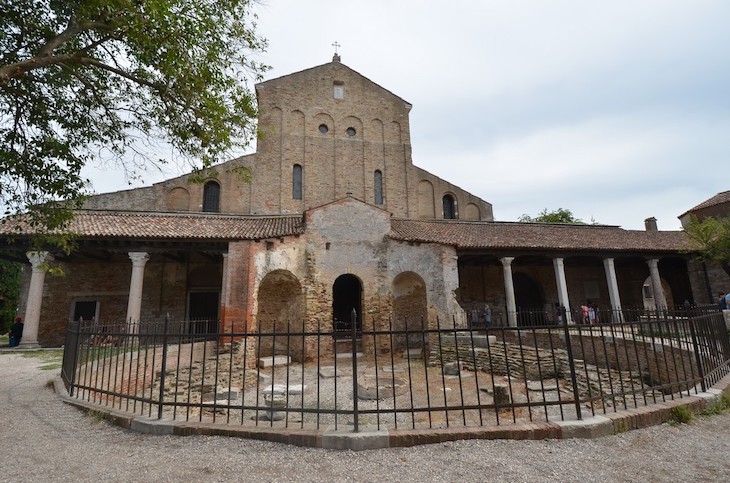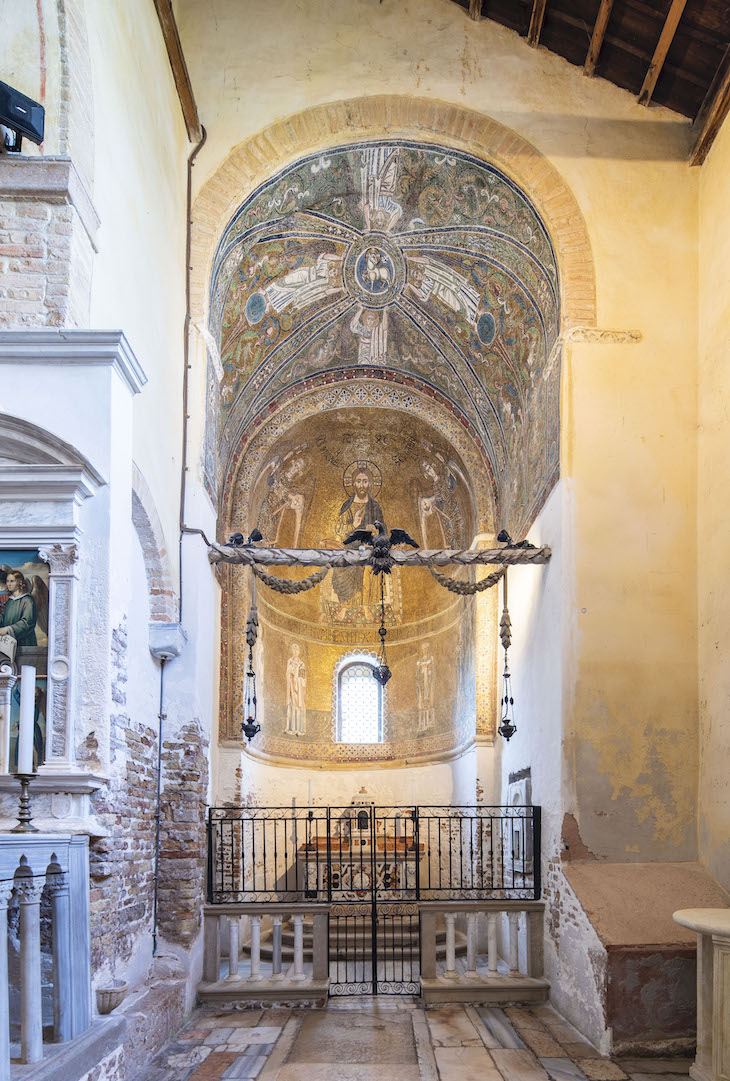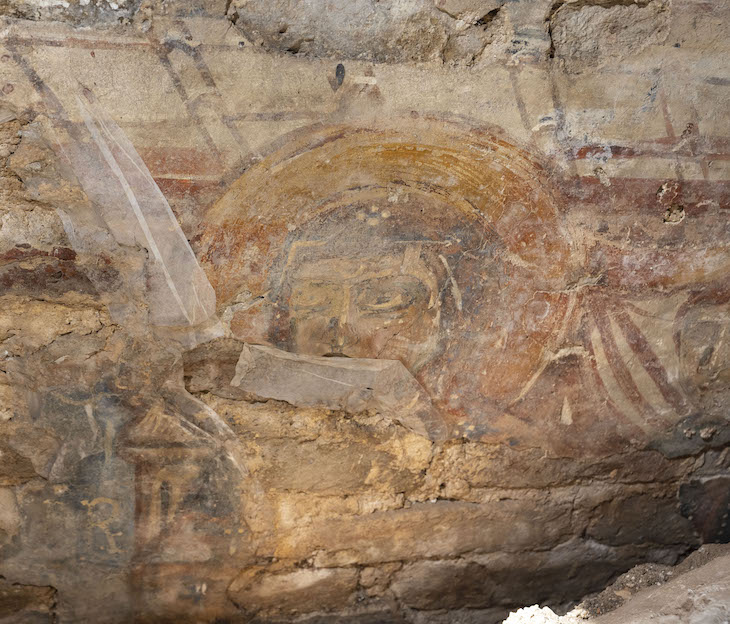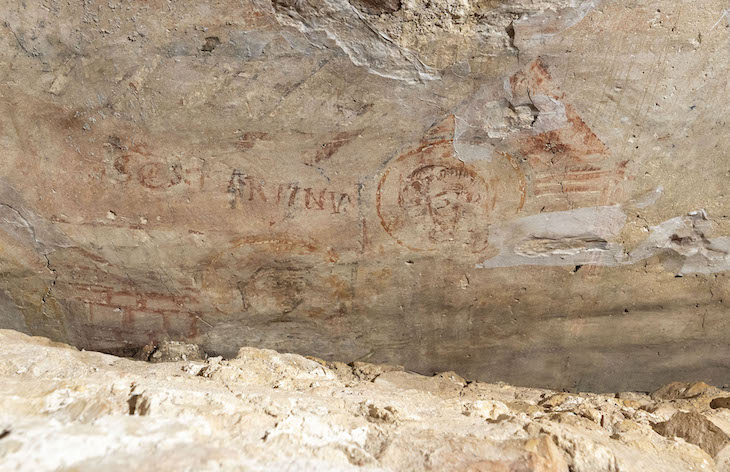The church of Santa Maria Assunta on the island of Torcello is adorned with some of the earliest surviving mosaics in the Venetian lagoon: the 11th-century Virgin Hodegetria in the main apse, Christ in Majesty in the south side apse, and the Last Judgement combined with the Harrowing of Hell on the counterfacade. During an ongoing conservation campaign, however – a collaboration between the American non-profit Save Venice, the diocese of Venice, and the Università Ca’ Foscari – fragments of much earlier figural wall paintings have recently been discovered, shedding new light on the early decoration of the church.

Santa Maria Assunta emerged as one of the earliest episcopal seats in the Venetian lagoon, although pinpointing its exact origins is difficult. According to a significantly later compilation, the so-called Chronicon Gradense by the Venetian chronicler John the Deacon (c. 940–c. 1018), the see existed by the year 579. However, an inscription in the church – also of questionable veracity – records that the cathedral was founded in 639 by the Byzantine exarch Isaac during the reign of emperor Herakleios (r. 610–41). This early structure was replaced by a larger three-aisled basilica in the ninth century; the building was then significantly renovated during the 11th century. The wall-painting fragments were discovered on ninth-century walls above the 11th-century vault in the apse on the south side, when an opening was made in the roof to examine the structural integrity of the vault.

The south side apse of Santa Maria Assunta, Torcello, showing the 11th-century mosaic of Christ in majesty
Two surviving narrative scenes can be distinguished, one on each side wall. With the help of palaeographical evidence from two fragmentary inscriptions, the archaeologist Diego Calaon and his team have dated the murals to the middle of the ninth century. The first wall painting, which survives in an especially damaged state, depicts a scene from the life of the fourth-century bishop St Martin of Tours (the inscription reads ‘[San]c[tu]s Martinus’). The scene from the life of the Virgin Mary (‘[M]ar[ia]’) on the opposite wall is in somewhat better condition. We can get a sense of the style of the master, who painted the face of the Virgin in a rough but expressive manner. Scholars have frequently argued that Venetian artists preferred other mediums to mural painting given the unfavourable climatic conditions. However, the wall paintings at Torcello suggest that the tradition of mural painting appeared early on in the Venetian lagoon.

Fresco (mid ninth century) showing a scene from the life of the Virgin Mary. Santa Maria Assunta, Torcello
They also offer a rare glimpse into the artistic development of the lagoon before it was completely dominated by Venice. Extensive archaeological research conducted over the last few decades in Comacchio, Altino, and Torcello has significantly advanced our understanding of the early economic development and the changing dynamics of power in the Adriatic. In the eighth and ninth centuries, the Venetian lagoon emerged as an important economic and commercial hub, with Byzantine and Carolingian agents competing for influence. Discussion of Torcello has tended to focus on its Byzantine connections, owing to the supposed foundation of Santa Maria Assunta by a Byzantine exarch and its 11th-century mosaics – but these wall paintings suggest that greater attention is due to Torcello’s connections with the Carolingian hinterland.
The presence of St Martin of Tours in Torcello is of particular importance, since his cult found few adherents in the Christian East. This newly discovered painting is also a remarkably early visualisation of the saint. The first known image of St Martin is the sixth-century mosaic of Sant’Apollinare Nuovo in Ravenna. There, he appears leading the procession of the Blessed. An example of the Charity of St Martin – the characteristic narrative episode of St Martin giving half of his cloak to a beggar – first appears on the illumination of the Fulda Sacramentary from around the last third of the 10th century. The Torcello mural is a considerably earlier testimony to the development of narrative context in the iconography of St Martin.

Fresco (mid ninth century) showing a scene from the life of the St Martin of Tours. Santa Maria Assunta, Torcello
The fragment shows two figures in front of a building. While the subject of the image is open for discussion given its present condition, the fact that both figures have halos suggests that this is not another depiction of St Martin’s Charity. Rather, the composition might represent St Martin being blessed or ordained by his early spiritual mentor, St Hilary. This scene is rarely depicted, and it suggests that the image at Torcello was probably part of a cycle. In the Merovingian and Carolingian era St Martin’s cloak became an important symbol of power, serving as the royal military banner. The wall painting at Torcello might show us new ways to understand how the tendrils of Carolingian influence in the Venetian lagoon reached not only into the spheres of economics and politics, but also devotional networks.
The mural on the opposite wall probably represents the Annunciation of the Virgin or the Visitation. While the person on the left side of the Virgin is too damaged to identify with certainty, Mary is accompanied by a servant maiden on her other side. This detail is not unusual in Carolingian imagery and served to emphasise the Virgin’s noble status as a matrona. While this feature appears only rarely after the Carolingian period, the Visitation mosaic of San Marco attests to its survival in around 1200. Such a small yet meaningful similarity between the two images prompts further investigation into artistic ties between Torcello and Venice over the longue durée. The newly discovered murals in Torcello not only add a new dimension to ongoing discussions about Byzantine and Carolingian competition in the north Adriatic, but open fresh lines of enquiry into the early artistic development of Venice and the lagoon.
Krisztina Ilko is a teaching associate in Italian Renaissance Art at the University of Cambridge.

Extra murals – on the discovery of medieval wall paintings on Torcello
Fresco (mid ninth century) showing a scene from the life of the Virgin Mary. Santa Maria Assunta, Torcello
Share
The church of Santa Maria Assunta on the island of Torcello is adorned with some of the earliest surviving mosaics in the Venetian lagoon: the 11th-century Virgin Hodegetria in the main apse, Christ in Majesty in the south side apse, and the Last Judgement combined with the Harrowing of Hell on the counterfacade. During an ongoing conservation campaign, however – a collaboration between the American non-profit Save Venice, the diocese of Venice, and the Università Ca’ Foscari – fragments of much earlier figural wall paintings have recently been discovered, shedding new light on the early decoration of the church.
Santa Maria Assunta emerged as one of the earliest episcopal seats in the Venetian lagoon, although pinpointing its exact origins is difficult. According to a significantly later compilation, the so-called Chronicon Gradense by the Venetian chronicler John the Deacon (c. 940–c. 1018), the see existed by the year 579. However, an inscription in the church – also of questionable veracity – records that the cathedral was founded in 639 by the Byzantine exarch Isaac during the reign of emperor Herakleios (r. 610–41). This early structure was replaced by a larger three-aisled basilica in the ninth century; the building was then significantly renovated during the 11th century. The wall-painting fragments were discovered on ninth-century walls above the 11th-century vault in the apse on the south side, when an opening was made in the roof to examine the structural integrity of the vault.
The south side apse of Santa Maria Assunta, Torcello, showing the 11th-century mosaic of Christ in majesty
Two surviving narrative scenes can be distinguished, one on each side wall. With the help of palaeographical evidence from two fragmentary inscriptions, the archaeologist Diego Calaon and his team have dated the murals to the middle of the ninth century. The first wall painting, which survives in an especially damaged state, depicts a scene from the life of the fourth-century bishop St Martin of Tours (the inscription reads ‘[San]c[tu]s Martinus’). The scene from the life of the Virgin Mary (‘[M]ar[ia]’) on the opposite wall is in somewhat better condition. We can get a sense of the style of the master, who painted the face of the Virgin in a rough but expressive manner. Scholars have frequently argued that Venetian artists preferred other mediums to mural painting given the unfavourable climatic conditions. However, the wall paintings at Torcello suggest that the tradition of mural painting appeared early on in the Venetian lagoon.
Fresco (mid ninth century) showing a scene from the life of the Virgin Mary. Santa Maria Assunta, Torcello
They also offer a rare glimpse into the artistic development of the lagoon before it was completely dominated by Venice. Extensive archaeological research conducted over the last few decades in Comacchio, Altino, and Torcello has significantly advanced our understanding of the early economic development and the changing dynamics of power in the Adriatic. In the eighth and ninth centuries, the Venetian lagoon emerged as an important economic and commercial hub, with Byzantine and Carolingian agents competing for influence. Discussion of Torcello has tended to focus on its Byzantine connections, owing to the supposed foundation of Santa Maria Assunta by a Byzantine exarch and its 11th-century mosaics – but these wall paintings suggest that greater attention is due to Torcello’s connections with the Carolingian hinterland.
The presence of St Martin of Tours in Torcello is of particular importance, since his cult found few adherents in the Christian East. This newly discovered painting is also a remarkably early visualisation of the saint. The first known image of St Martin is the sixth-century mosaic of Sant’Apollinare Nuovo in Ravenna. There, he appears leading the procession of the Blessed. An example of the Charity of St Martin – the characteristic narrative episode of St Martin giving half of his cloak to a beggar – first appears on the illumination of the Fulda Sacramentary from around the last third of the 10th century. The Torcello mural is a considerably earlier testimony to the development of narrative context in the iconography of St Martin.
Fresco (mid ninth century) showing a scene from the life of the St Martin of Tours. Santa Maria Assunta, Torcello
The fragment shows two figures in front of a building. While the subject of the image is open for discussion given its present condition, the fact that both figures have halos suggests that this is not another depiction of St Martin’s Charity. Rather, the composition might represent St Martin being blessed or ordained by his early spiritual mentor, St Hilary. This scene is rarely depicted, and it suggests that the image at Torcello was probably part of a cycle. In the Merovingian and Carolingian era St Martin’s cloak became an important symbol of power, serving as the royal military banner. The wall painting at Torcello might show us new ways to understand how the tendrils of Carolingian influence in the Venetian lagoon reached not only into the spheres of economics and politics, but also devotional networks.
The mural on the opposite wall probably represents the Annunciation of the Virgin or the Visitation. While the person on the left side of the Virgin is too damaged to identify with certainty, Mary is accompanied by a servant maiden on her other side. This detail is not unusual in Carolingian imagery and served to emphasise the Virgin’s noble status as a matrona. While this feature appears only rarely after the Carolingian period, the Visitation mosaic of San Marco attests to its survival in around 1200. Such a small yet meaningful similarity between the two images prompts further investigation into artistic ties between Torcello and Venice over the longue durée. The newly discovered murals in Torcello not only add a new dimension to ongoing discussions about Byzantine and Carolingian competition in the north Adriatic, but open fresh lines of enquiry into the early artistic development of Venice and the lagoon.
Krisztina Ilko is a teaching associate in Italian Renaissance Art at the University of Cambridge.
Unlimited access from just $16 every 3 months
Subscribe to get unlimited and exclusive access to the top art stories, interviews and exhibition reviews.
Share
Recommended for you
What did Venice look like to a medieval pilgrim from Tuscany?
A 14th-century sketch by a travelling friar is now thought to be the earliest known drawing of the city
Stepping back in time at Palazzo Grimani in Venice
Returning the Grimani sculpture collection to its dramatic 16th-century setting feels like a dream, says Toto Bergamo Rossi
Unearthing the secrets of the Anglo-Saxon world
Paganism and Christianity are intertwined in the hoard of rare artefacts found in a princely burial site in Essex